For perfect lye soap, maintain temperatures between 90-110°F (32-43°C) for both oils and lye solution, keeping them within 10°F of each other. Heat oils to 120-130°F first to guarantee they're fully melted, then cool. Allow fresh lye solution to cool from its initial 200°F to match oil temperatures. In summer, aim lower (around 100°F); in winter, go higher (approximately 110°F). Follow these temperature guidelines to prevent false trace and achieve consistent, high-quality soap every time.
Complete Temperature Guide for Perfect Lye Soap Results
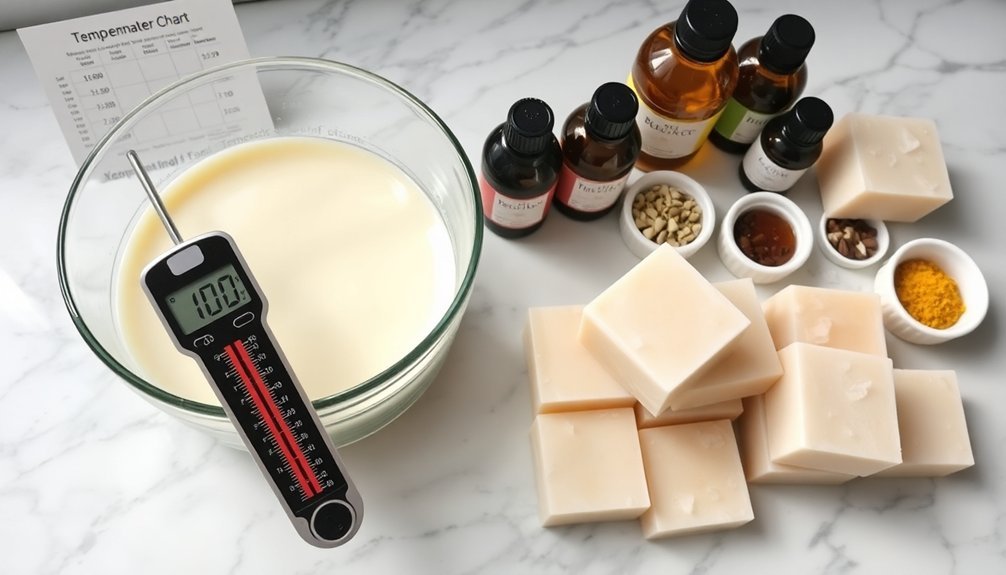
While many aspects of soap making require careful attention, temperature control stands as one of the most critical factors for success.
When creating cold process soap, you'll want to maintain both your oils and lye solution between 90°F to 110°F (32°C to 43°C) for ideal results.
Keep your oils and lye temperatures within 10 degrees of each other to promote proper saponification. This prevents common issues like false trace, where oils prematurely solidify upon contact with lye rather than truly saponifying.
For precision, invest in a digital laser thermometer to monitor temperatures accurately.
If you're working with layered designs, you might benefit from slightly higher temperatures (though stay below 120°F) to accelerate trace.
Remember that temperature affects not just your mixing process but also curing time and final soap quality.
The Science Behind Temperature in Soap Making
Temperature plays a foundational role in soap chemistry that's worth understanding before you reach for your thermometer.
During saponification process, the reaction between your soap making oils and lye solution creates a chemical transformation that's highly temperature-sensitive.
When temperatures fall below 90°F, fatty acids may solidify, preventing proper saponification and potentially causing false trace. Conversely, temperatures exceeding 110°F accelerate the reaction, sometimes too quickly for proper mixing.
This delicate balance affects not just how fast you reach trace, but also your soap's final texture and appearance.
The ideal range of 90-110°F guarantees that oils remain clear and fully melted while keeping the lye solution at a manageable temperature.
This sweet spot promotes complete saponification without aesthetic defects like soda ash or glycerin rivers.
Ideal Temperature Ranges for Lye Solutions
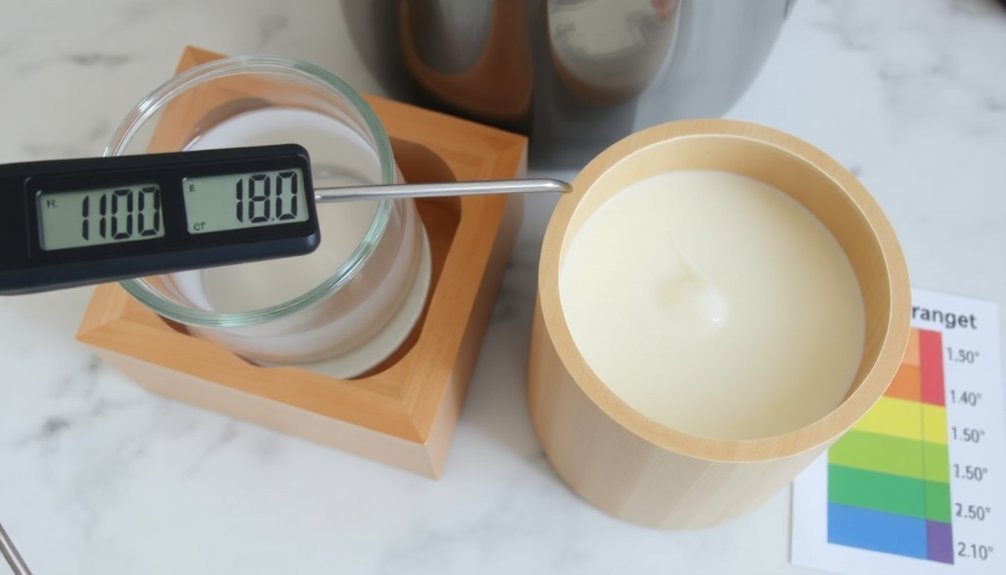
When working with lye, you'll need to prioritize safety by wearing protective gear and ensuring proper ventilation before measuring temperatures.
You should cool your freshly mixed lye solution to 120°F-130°F before combining it with oils in cold process soap making.
Your digital thermometer will be your most valuable tool for achieving the correct temperature range and preventing common issues like false trace or accelerated saponification.
Safety First Considerations
Because working with lye demands careful attention to temperature, you'll need to maintain specific ranges throughout your soap-making process.
Always remember that lye solutions can reach dangerous temperatures up to 200°F due to exothermic reactions.
For safety first practices, never add water to lye—always add lye to water. Then allow your lye solution to cool to the ideal temperature range of 120-130°F before combining with oils.
Experienced soap makers maintain temperatures within 10°F between lye solution and oils to prevent false trace and guarantee proper saponification.
Using temperatures that are too low can lead to premature thickening without proper chemical reactions.
Cold Process Specifics
Although many soap makers debate exact temperatures, successful cold process soaping requires maintaining your lye solution between 120°F to 130°F (49°C to 54°C).
When you first mix lye with water, the solution can reach temperatures up to 200°F (93°C) due to the exothermic reaction, so you'll need to allow it to cool before use.
Keep your oils and butters within 10 degrees of your lye solution's temperature to promote proper emulsification.
This temperature harmony prevents separation and reduces the risk of false trace—a deceptive thickening that occurs when cooler lye meets solidifying oils rather than true saponification.
Ensure all oils are fully melted and clear before combining with your lye solution.
If your lye is too cold, it may cause oils to solidify on contact; too hot, and it'll accelerate saponification uncontrollably.
Optimal Oil Temperature for Different Soap Recipes
You'll find that hard oils like cocoa butter and shea butter demand temperatures above their melting points (93°F and 84°F respectively) to achieve proper incorporation in your soap recipe.
Controlling trace becomes easier when you match your oil temperature to your specific formula, with higher temperatures (120-130°F) accelerating trace while cooler oils (90-110°F) provide more working time.
For recipes high in hard oils, maintaining temperatures between 100-110°F will give you the perfect balance of workability and proper saponification.
Hard Oil Considerations
When working with soap recipes containing hard oils and butters, maintaining proper temperature control becomes critical for success.
Hard oils like cocoa butter (93°F), palm oil (96°F), and shea butter (84°F) must be fully melted and kept at 120-130°F to avoid false trace. If your temperatures drop below 85°F, these oils will begin to solidify, creating grainy soap batter and preventing proper mixing.
Always melt your hard oils first before adding liquid oils, and verify they're completely clear before combining with your lye solution.
Keep both components within 10 degrees of each other for ideal saponification. However, be careful not to exceed 120°F during mixing, as this can accelerate trace and interfere with intricate designs.
Proper temperature management of hard oils creates smoother, more consistent soap with predictable working times.
Trace Control Techniques
Mastering trace control begins with understanding how temperature affects different oil combinations in your soap recipes. When your lye water and oil mixture meet at around 100°F (38°C), trace occurs at a predictable rate, giving you ideal control over your design.
To prevent false trace, guarantee all oils are completely melted and clear before combining ingredients.
- Imagine your soap batter flowing like warm honey at 100°F, perfect for swirls and detailed patterns.
- Picture the accelerated thickening at higher temperatures (120-130°F), creating distinct layers that hold their shape.
- Visualize the slower-moving batter at cooler temperatures (90-110°F), giving you extended working time for intricate designs.
Working with olive oil and soft oils? Keep temperatures steady at 100°F to achieve proper emulsification without separation, guaranteeing your creative vision comes to life.
How to Accurately Measure Soap Making Temperatures
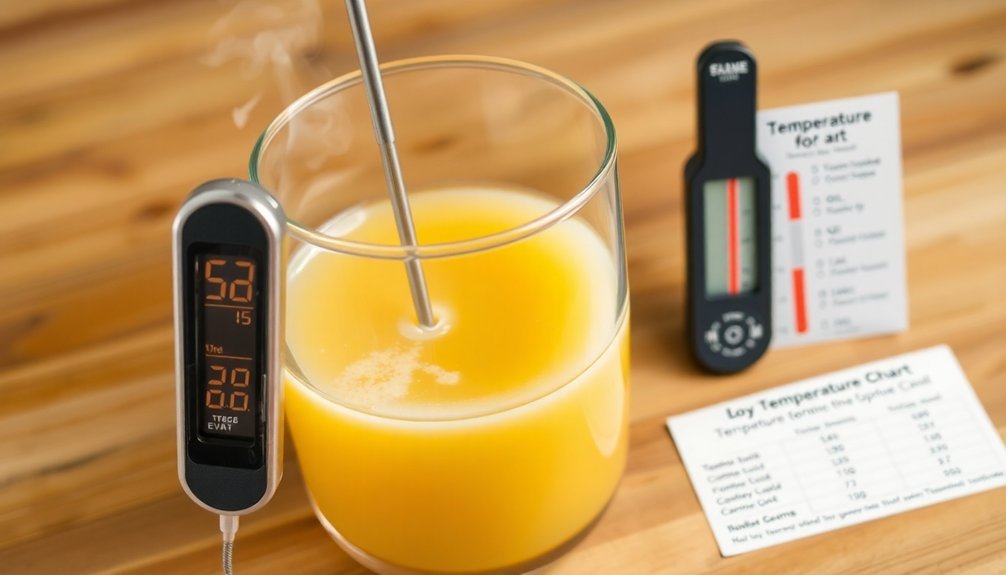
Although soap making seems like an art, precise temperature measurement is the science behind successful batches. Invest in a digital laser thermometer for accurate measurement of both lye solutions and oils. This precision tool guarantees you'll hit the ideal ranges every time.
Aim to bring your lye solution to 120-130°F before allowing it to cool to around 100°F for mixing. Your oils should be within 10°F of your lye temperature—ideally also around 100°F—to prevent false trace and guarantee proper saponification.
When working with butters like cocoa (melting point 93°F) or shea (melting point 84°F), temperature monitoring becomes even more critical to avoid solidification issues.
Consistent temperature control throughout the soap making process is your key to predictable, successful batches.
Preventing False Trace: Temperature Control Techniques
False trace represents one of the most common pitfalls in soap making, often confusing beginners and frustrating experienced crafters alike. To avoid this issue, maintain both your oils and lye solution at approximately 100°F (38°C) to guarantee proper saponification without premature thickening.
For ideal temperature control:
- Confirm oils are completely melted and clear at 120-130°F (49-54°C), then allow to cool before combining with lye.
- Cool your lye solution below 110°F (43°C) to prevent accelerated trace that can compromise soap quality.
- Implement the heat transfer method to naturally balance temperatures when mixing solid and liquid oils.
When temperatures drop below 90°F (32°C), your soap batter may falsely appear traced with a grainy, thickened texture that hasn't actually completed the saponification process.
Temperature Considerations for Cold Process Soap Making
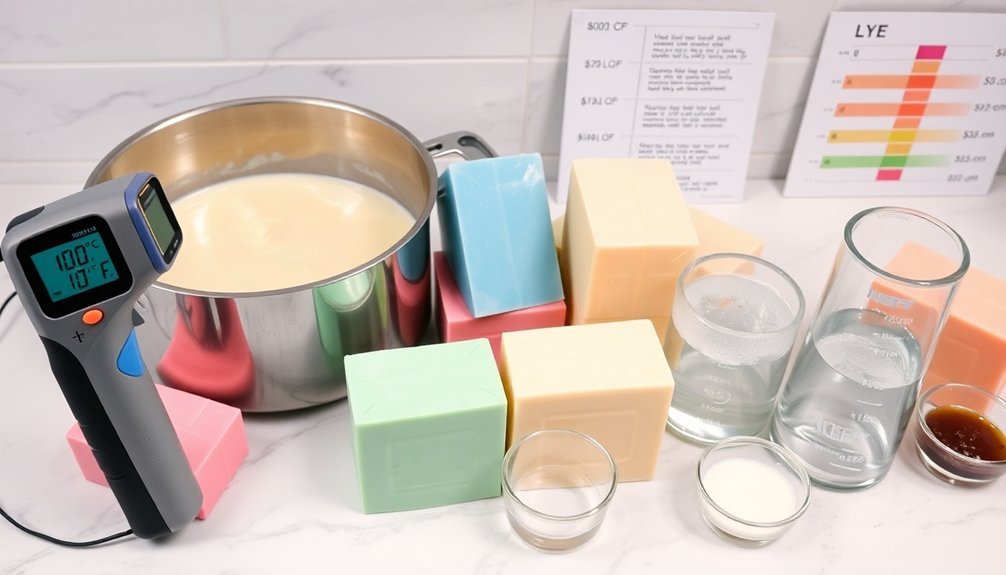
Successful cold process soap making hinges on maintaining precise temperature control throughout the entire process. When mixing lye solution with oils, aim for temperatures between 90-110°F (32-43°C) to guarantee proper saponification without false trace issues.
| Temperature Range | Effect on Soap | Recommendation |
|---|---|---|
| Below 90°F (32°C) | May solidify oils, causing false trace | Warm oils before adding lye to water |
| 90-110°F (38-43°C) | Ideal soaping temperature for smooth reactions | Keep lye and oils within 10°F of each other |
| Above 120°F (49°C) | Accelerates trace, complicates intricate designs | Avoid for most cold process recipes |
Your oils should be completely clear and melted at 120-130°F before cooling to your target temperature. This preparation prevents fatty acids from solidifying prematurely when introducing your cooled lye solution.
Hot Process Soap Making: Temperature Requirements
When making hot process soap, you'll need to melt your oils to 130-160°F in the cooking pot before adding your lye solution.
Unlike cold process methods, you don't need to cool your lye solution first since the higher temperatures actually accelerate the saponification reaction.
Throughout the cooking process, you'll want to maintain sufficient heat to keep your soap mixture in the gel phase, which enhances color and reduces overall production time.
Initial Melt Temperature
The opening phase of hot process soap making demands precise temperature control during the oil melting stage.
You'll want to warm and melt your oils directly in your cooking pot before adding your lye solution. Unlike cold process methods, you don't need to cool your lye solution first—adding hot lye to warm oils actually accelerates the saponification reaction.
For ideal temperatures, aim for the 131°F to 160°F range, which promotes:
- A smooth, velvety consistency as the oils transform into a golden liquid bath
- A vibrant gel phase that enhances your soap's colors and clarity
- A uniform texture free from glycerin rivers or separation
Always use a thermometer to monitor temperatures precisely—overheating risks volcano-like eruptions, while insufficient heat may leave your saponification reaction incomplete.
Oil-Lye Mixing Range
With your oils properly melted, you'll now need to focus on the oil-lye combination—a process that demands careful attention to temperature compatibility.
In hot process soap making, aim to heat your oils to 131-160°F (55-71°C) to create ideal conditions for saponification.
Unlike cold process methods, you don't need to cool your lye solution before combining it with oils. Maintain your lye solution at 120-130°F (49-54°C) when mixing with your warm oils. This temperature harmony accelerates the saponification reaction considerably.
The beauty of hot process is that the direct combination of hot lye with warm oils jumpstarts the chemical reaction immediately.
Always monitor both temperatures throughout the process—this vigilance prevents common issues like separation or incomplete saponification that can ruin your batch of soap.
Cooking Heat Levels
Successful hot process soap making hinges on proper heat control during the cooking phase. After melting your oils to 120-130°F, you'll add the lye solution to initiate saponification. Unlike cold process, you don't need exact temperature matching, but maintaining consistent heat drives the reaction forward efficiently.
Your cooking pot should reach 131-160°F to promote the gel phase, which enhances color vibrancy and reduces soda ash formation. Monitor carefully to prevent overheating, which can cause defects in your final product.
- Imagine your oils gently bubbling as they transform from slick liquid to thick, mashed potato-like soap.
- Picture the translucent, vaseline-like appearance indicating successful gel phase completion.
- Visualize a smooth, glossy texture forming as the soap cooks to perfection.
Seasonal Adjustments for Soap Making Temperatures
Seasonal changes significantly impact your soap making process, requiring thoughtful temperature adjustments throughout the year.
Maintain a consistent working temperature between 90°F and 110°F regardless of outside conditions to guarantee reliable results.
During summer months, cool your lye solution and oils to around 100°F to prevent accelerated trace and overheating issues like glycerin rivers or soap volcanoes.
Conversely, in winter, warm oils to approximately 110°F to fully melt solid fats and avoid false trace caused by premature solidification.
When working with temperature-sensitive ingredients like milk or juice, aim for the cooler end of the range (100°F-110°F).
Always factor in weather conditions when timing your lye preparation—on cold days, mix your lye solution earlier to allow proper cooling before combining with oils.
Troubleshooting Temperature-Related Soap Issues
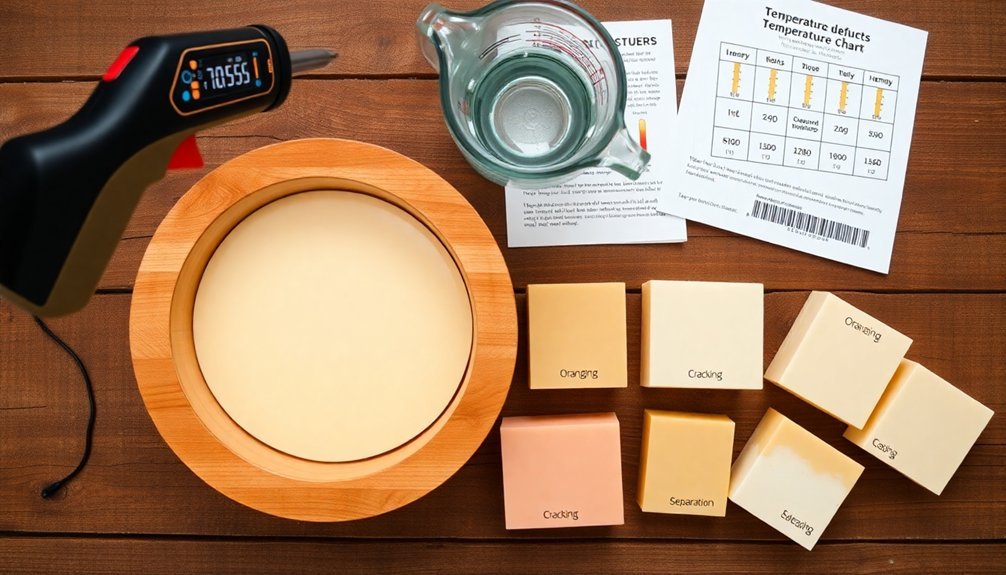
Even the most carefully planned soap batches can develop problems when temperatures aren't properly managed.
If you're mixing lye solution and oils with temperatures too far apart (beyond 10°F difference), you'll likely encounter false trace—a premature thickening that results in grainy, separated soap. Cold lye solution (below 90°F) can solidify oils on contact, preventing proper saponification.
- Imagine your soap developing "alien brain" patterns across its surface when high temperatures over 120°F accelerate trace too quickly.
- Picture the disappointment of unmolding a soap covered in white, powdery soda ash because your batch was mixed at temperatures too low.
- Visualize a dramatic soap volcano erupting from your mold when excessive heat builds up during saponification.
Monitor both lye and oil temperatures throughout the process to avoid these common pitfalls.
The Heat Transfer Method: When and How to Use It
While many soapmakers struggle with managing separate temperatures, the Heat Transfer Method offers an elegant solution by using the natural heat of your lye solution to melt solid oils directly in the mixing container.
This approach works particularly well for recipes with high soft oil content, eliminating the need for additional heating equipment.
To implement this method, simply weigh your solid oils into your soap pot, then pour your hot lye solution over them. Gently stir until the oils completely melt, typically reaching the ideal 120-130°F range.
Remember to take into account the melting points of your specific oils—cocoa butter (93°F) and coconut oil (76°F) respond differently to heat.
This technique prevents false trace by ensuring all solid oils fully melt, promoting a uniform saponification process throughout your soap batch.
Frequently Asked Questions
What Temperature Should Lye Soap Be?
You'll want to mix your lye and oils between 90°F-110°F (32°C-43°C), keeping them within 10 degrees of each other. This temperature range guarantees ideal saponification and prevents false trace in your soap.
What Is the Best Temperature for Saponification?
For ideal saponification, aim to keep both your lye solution and oils between 90-110°F (32-43°C). You'll want these temperatures within 10 degrees of each other to guarantee proper chemical reaction and avoid false trace issues.
What Is the Best Temperature to Cure Soap?
You'll want to cure your soap at 70°F to 85°F (21°C to 29°C). This temperature range guarantees proper saponification completion while avoiding issues like soda ash formation or extended curing times from cooler temperatures.
What Happens if Lye Is Too Cold?
If your lye is too cold, you'll get false trace and grainy soap. It solidifies oils on contact, prevents proper saponification, extends mixing time, and creates inconsistent batters that compromise your final soap quality.
In Summary
When you've mastered temperature control, you'll see a dramatic improvement in your soap making results. Remember, it's not about rigid rules but understanding how temperature affects your specific recipe and ingredients. Keep notes on what works best for your process, adjust for seasonal changes, and don't hesitate to experiment. With practice, you'll develop an intuitive feel for perfect temperatures every time.

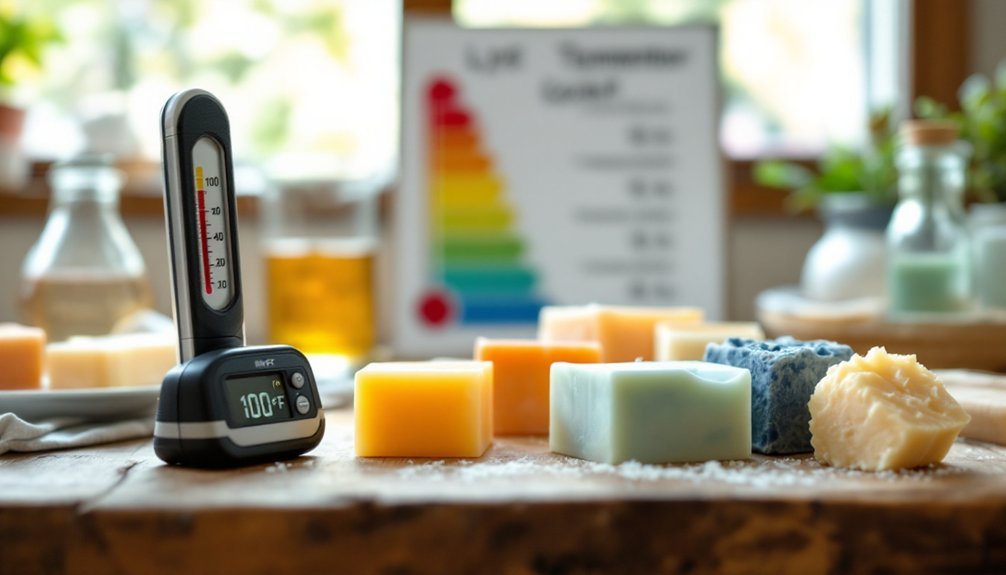



Leave a Reply